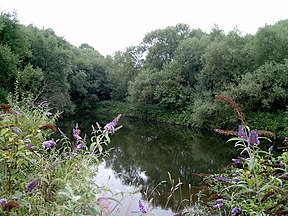Ketley Canal
| Ketley Canal | |
|---|---|

A small part of the canal in Paddock Mount, Ketley still holds water
|
|
| Specifications | |
| Locks | 1 + 1 inclined plane |
| Status | mostly destroyed |
| History | |
| Principal engineer | William Reynolds |
| Date of act | Privately built |
| Date of first use | 1788 |
| Date closed | 1880s |
| Geography | |
| Connects to | Shropshire Canal |
The Ketley Canal was a tub boat canal that ran for about 1.5 miles (2.4 km) from Oakengates to Ketley works in Shropshire, England. The canal was built about 1788 and featured the first inclined plane in Britain. The main cargo of the canal was coal and ironstone (a form of iron ore). The inclined ceased to be used in 1816, when Ketley Works was closed, but the upper canal was not finally abandoned until the 1880s. A few traces of the canal are still visible in the landscape.
The Ketley canal was constructed between 1787 and 1788 by William Reynolds of Ketley. Reynolds was born in 1758 at Bank House, Ketley, the son of the ironmaster and philanthropist Richard Reynolds. His father managed the works at Coalbrookdale from 1763 to 1768, following the death of Abraham Darby II and the coming of age of his son, Abraham Darby III. Reynolds served his apprenticeship while his father was manager, and it was a period of great innovation, including the first use of iron rails. He became the most innovative and able of the various Shropshire ironmasters, and met with several engineers who visited Coalbrookdale regularly, including Matthew Boulton, James Watt, John Wilkinson, Lord Dundonald and Thomas Telford. He was also friendly with a group of intellectuals, centred on Joseph Plymley. In 1786, he constructed the Coalport Tar Tunnel, originally intended as a low-level access to mines further to the north, but discontinued when the excavations reached a source of natural bitumen. In the following year, he built the Wombridge Canal. Reynolds and his father started work on the Ketley Canal in 1787, in order to transport ironstone and coal from Oakengates to their foundries at Ketley. It ran in a westerly direction from Oakengates, passing through a tunnel where Shepherds Lane crossed Red Lake Hill, and ended to the south of Ketley Hall. At this point there was a 73-foot (22.3 m) drop to his works.
...
Wikipedia
